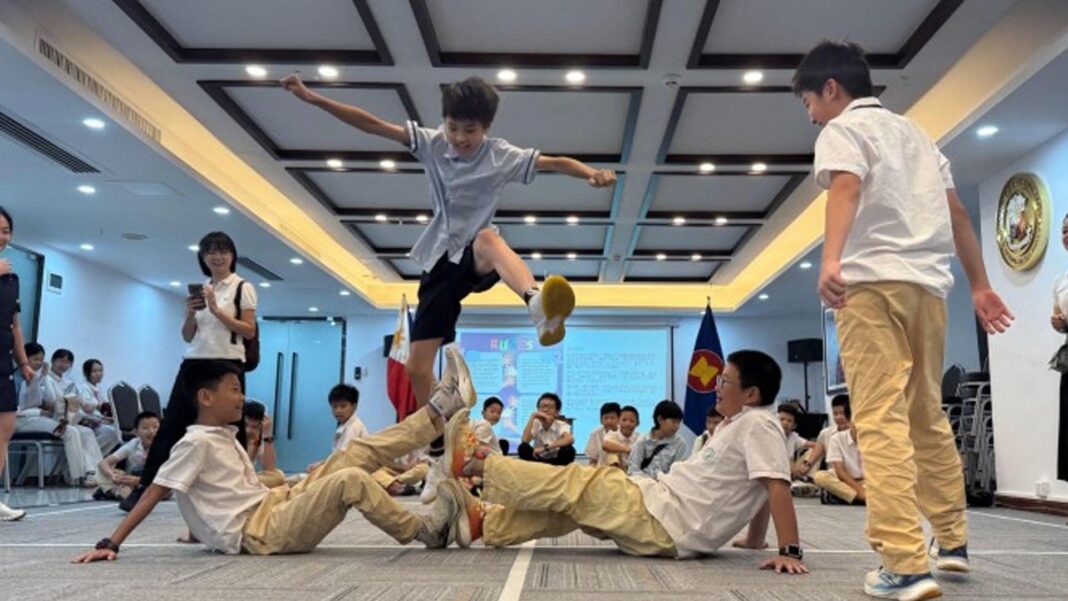A colorful and lively celebration of friendship was recently held at Jingshi Aoyuan Nanao Experimental School, Guangzhou city, Guangdong province, southern China, as the Philippine Consulate General in the city launched the “Building Bridges” initiative, a special program as part of the Language Month and the 50th anniversary of the formal establishment of diplomatic relations between the Philippines and China.
Thirty selected students participated in the activities that introduced, not only Philippine games and riddles, but also the deeper spirit of culture and unity championed by the two countries.
Patintero, Luksong Tinik and Sipa proved that tradition never gets old.
With every shout and laugh, the Chinese students were shared the spirit of teamwork, strategy, and perseverance – characteristics that Filipino students also learn in schools.
For the students of Jingshi Aoyuan Nanao Experimental School, this was the first time they experienced the games that Filipino children grew up with.
With simple drawings on the floor and agile movements, the spirit of “barriolympics” came to life, which is directly inspired by Philippine street games.
Riddles, a bridge of understanding
Along with the games, the students were also fascinated by the colorful kites with riddles written in various Philippine dialects – such as Tagalog, Cebuano, Ilokano, Waray, Pangasinense, Aklanon, and Chavacano.
Each one came with an English translation so that Chinese students could better understand it.
In their attempt to solve the riddles, the students discovered their similarities to the Chinese 谜语( mí yǔ) — a clear proof that, despite the ocean separating the Philippines and China, the creative thinking and appreciation of the language of Filipinos and Chinese people still converge.
谜语 (mí yǔ) is called a riddle or puzzle in Chinese culture.
It is a form of traditional word game that uses clues, metaphors, and hidden meanings to test the intelligence and imagination of the answerer.
Like in the Philippines, 谜语 (mí yǔ) is usually played during gatherings and celebrations, especially during the Lantern Festival (Yuanxiao Jie) where the riddles are written on paper hung from lanterns.
Pinoy flavor
It was not only the mind and body that were strengthened that day.
The students also tasted the sweetness, sourness, and flavor of Filipino foods, as they tasted ensaymada and ube from Mary Sweets, a Filipino company based in Guangdong.
In addition, their thirst was quenched with cold lemonade, or blended lime juice.
At the end of the program, the youth happily received “Love the Philippines” bags, which contained tourist brochures and food made by Oishi – a small reminder of their unique and extraordinary experience.
Language as spirit of unity
Buwan ng Wika is an annual celebration held every August in the Philippines, and according to Iric Arribas, Consul General of the Philippines in Guangzhou, it aims to promote Filipino and other indigenous languages of the country as pillars of national unity.
Under the theme “Developing Filipino and Native Languages: A History of National Unity,” the role of language is emphasized not only as a means of communication, but also as a bridge to understanding people and cultures, Arribas added.
Deeper friendship
Overall, the event was more than just a simple program.
With every game, riddle, and meal, the Chinese youth had the opportunity to see the Philippines not only as a neighboring country, but as a friend and partner in the development of culture and respect for diversity.
As “Building Bridges” continues, the path to a stronger and more enduring understanding between Filipinos and Chinese is being paved. (PNA)


